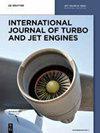CFD analysis of flow control in compressor cascade using MVGs
IF 0.9
4区 工程技术
Q4 ENGINEERING, AEROSPACE
引用次数: 0
Abstract
Abstract The present study reports the numerical investigation of the compressor cascade. To minimize the separation phenomenon in the compressor cascade, a passive flow control device i.e. Micro Vortex Generator (MVG) is utilized. MVG is a very simple and lightweight attachment mounted infront of the leading edge of the cascade blade. Due to being passive in nature, it neither consumes power nor requires any external device to actuate. The numerical simulations were carried out on a highly loaded compressor cascade at an angle of incidence of −1° under subsonic conditions at Mach number 0.2. The profile of the compressor cascade blade was double circular arc (DCA), unsymmetrical and cambered at 40°. Two different types of micro vortex generators were mounted infront of the leading edge in the compressor cascade to control the secondary flows since secondary flows were responsible for various losses in cascade. To analyze the flow under incompressoible state of air (M = 0.2), Star CCM + software has been used. To simulate the flow under turbulent condition, k-ω SST turbulence model was used. A velocity profile of 25 mm boundary layer thickness was extracted and used as an input in the compressor cascade. Mounting of MVG on compressor cascade enhanced drag but also increased lift. Total pressure loss coefficient (TPLC) was calculated to compare the losses. The aerodynamic efficiency in terms of coefficient of lift and coefficient of drag has been used to study the effect of MVG over cascade. It is found that there is reduction in total pressure loss coefficient (TPLC) for trapezoidal and curved trapezoidal types of MVGs and the decrease in percentage are 2.17 and 8.86%, respectively. Alos, aerodynamic efficiency is increased by mounting trapezoidal and curved trapezoidal types of MVG and the increase in percentages are 2.03 and 3.10%, respectively.基于MVG的压气机叶栅流量控制CFD分析
摘要本研究报告了压缩机叶栅的数值研究。为了最大限度地减少压缩机叶栅中的分离现象,使用了一种被动流量控制装置,即微涡流发生器(MVG)。MVG是一种安装在叶栅叶片前缘的非常简单和轻便的附件。由于本质上是被动的,它既不耗电,也不需要任何外部设备来驱动。数值模拟是在马赫数为0.2的亚音速条件下,以−1°的入射角对高负荷压气机叶栅进行的。压缩机叶栅叶片的轮廓为双圆弧,不对称,在40°时呈弧形。两种不同类型的微涡流发生器安装在压缩机叶栅前缘前,以控制二次流,因为二次流是叶栅中各种损失的原因。为了分析空气在不可压缩状态(M=0.2)下的流动,使用了Star CCM+软件。为了模拟湍流条件下的流动,采用了k-ωSST湍流模型。提取了25mm边界层厚度的速度剖面,并将其用作压缩机叶栅的输入。MVG在压缩机叶栅上的安装增强了阻力,但也增加了升力。计算总压力损失系数(TPLC)以比较损失。利用升力系数和阻力系数的气动效率来研究MVG对叶栅的影响。研究发现,梯形和弯曲梯形MVG的总压力损失系数(TPLC)分别降低了2.17%和8.86%。此外,安装梯形和弯曲梯形MVG可提高空气动力学效率,百分比分别增加2.03%和3.10%。
本文章由计算机程序翻译,如有差异,请以英文原文为准。
求助全文
约1分钟内获得全文
求助全文
来源期刊

International Journal of Turbo & Jet-Engines
工程技术-工程:宇航
CiteScore
1.90
自引率
11.10%
发文量
36
审稿时长
6 months
期刊介绍:
The Main aim and scope of this Journal is to help improve each separate components R&D and superimpose separated results to get integrated systems by striving to reach the overall advanced design and benefits by integrating: (a) Physics, Aero, and Stealth Thermodynamics in simulations by flying unmanned or manned prototypes supported by integrated Computer Simulations based on: (b) Component R&D of: (i) Turbo and Jet-Engines, (ii) Airframe, (iii) Helmet-Aiming-Systems and Ammunition based on: (c) Anticipated New Programs Missions based on (d) IMPROVED RELIABILITY, DURABILITY, ECONOMICS, TACTICS, STRATEGIES and EDUCATION in both the civil and military domains of Turbo and Jet Engines.
The International Journal of Turbo & Jet Engines is devoted to cutting edge research in theory and design of propagation of jet aircraft. It serves as an international publication organ for new ideas, insights and results from industry and academic research on thermodynamics, combustion, behavior of related materials at high temperatures, turbine and engine design, thrust vectoring and flight control as well as energy and environmental issues.
 求助内容:
求助内容: 应助结果提醒方式:
应助结果提醒方式:


